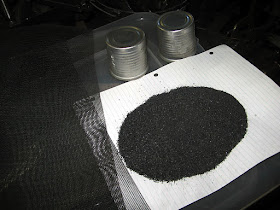


I wrote some about this back in late May. Today the issue came up again as I had to make about 100 black lag screws, 5/16” x 1.5” and 5/16” x 2.5” and decided to take a couple of images to better explain the technique. Since almost everything I make has a black finish I like to make sure the mounting hardware matches. I have square head hardware to use when it seems most appropriate but most things mount with standard hex head lag screws which I modify to get the right color finish.
Step one is to remove the galvanizing with a 10 minute soak in hydrochloric acid. I explained that last April in “The Pickling Bucket”.
Step two is rinsing with water and drying. A light rust color appears.
Step three is shown in the image showing the screws inserted in the vise jig I use to hold nine at a time to dress the heads.
Step four is to polish off the factory lettering on the heads with a flap disc on an angle grinder.
Step five is to heat each head with the torch using a slightly reducing flame to barely melt the surface surface and glaze to remove the abrasive streaks.
The final step is to spread them out in a pan and spray them with Minwax clear satin polyurethane.
I got this tip back in my woodworking days. When I’m gathering things to do a mounting project I stick the screws into a toilet bowl wax ring. The urethane wax is an excellent lubricant which, in addition to a pilot hole, makes screw insertion easy. Here is a picture of the type of ring I’m describing if it’s not already clear.
http://www.oatey.com/apps/catalog/instance_assets/assets/Photo/Wax_Ring_31195.jpg












